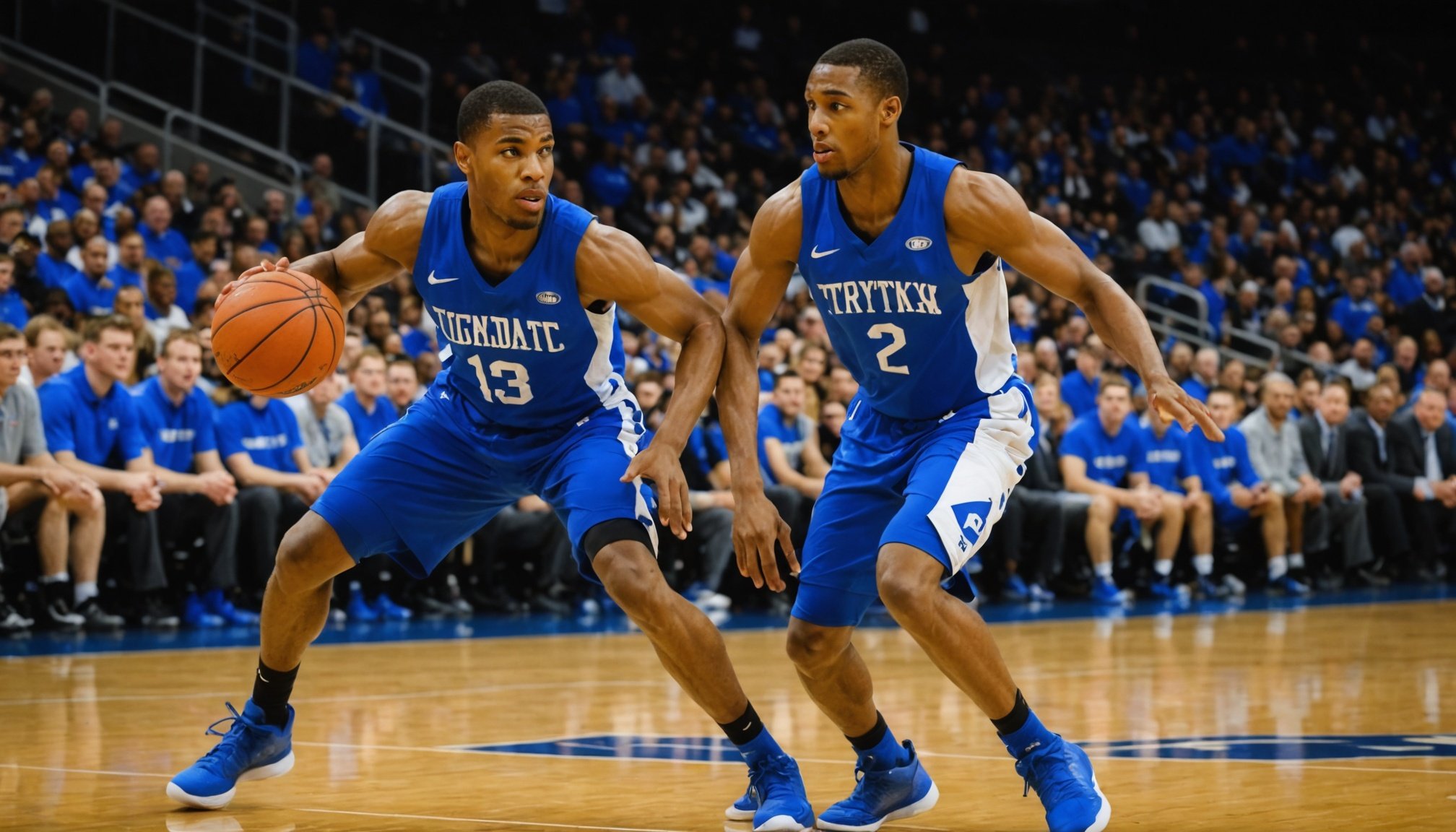Evidence-Based Workout Strategies
Tailoring workout strategies for basketball players requires attention to both physical and sport-specific dimensions. An effective routine focuses on basketball training that enhances performance on the court. Central to this is the concept of periodization, which involves strategically planning workouts around the competitive season. This method ensures players peak physically at the right moments, managing fatigue and reducing injury risk.
Periodization and its Importance
Periodic adjustments to training loads and intensity are essential. By aligning workouts with the competitive calendar, athletes can maintain optimum energy levels. Incorporating recovery periods is crucial to sustain long-term performance, as it allows the body to repair and strengthen.
Also to see : Transform your skills: top agility drills every uk basketball player should master
Sport-Specific Drills
Basketball training isn’t only about agility and strength. Incorporating sport-specific drills can significantly improve skills like dribbling, shooting accuracy, and defensive maneuvers. These drills mimic in-game scenarios, enabling players to translate practice into performance more effectively.
Components of Effective Routines:
- Strength Training: Increases muscle power for explosive movements.
- Endurance Training: Enhances stamina for sustained activity.
- Agility Drills: Boosts reaction time and footwork.
In conclusion, integrating tailored workout strategies within basketball training not only fortifies physical capabilities but also amplifies on-court performance.
Also read : Enhance your fast-break skills: essential court vision strategies for uk basketball athletes
Nutrition Tips for Optimal Performance
Achieving optimal performance in basketball requires adhering to effective sports nutrition principles. A balanced diet rich in key macronutrients and micronutrients ensures players have the energy and resilience needed on the court.
Key Nutrients for Basketball Players
Basketball players should focus on a diet incorporating carbohydrates, proteins, and fats in appropriate proportions. Carbohydrates act as the primary fuel source, while proteins aid in muscle repair and growth. Essential fats contribute to hormonal balance and joint health. Micronutrients, like vitamins and minerals, support metabolic processes and immune function.
Meal Timing and Hydration
Strategic meal planning enhances energy utilisation. Consuming carbohydrate-rich foods a few hours before a game provides a steady energy supply. Post-game nutrition, focusing on proteins and carbs, assists in recovery. Hydration is critical: maintaining adequate fluid levels before, during, and after games prevents fatigue and optimises performance.
Sample Meal Plans
Incorporate balanced meals and snacks that are nutritionally dense. A pre-game meal could include whole-grain pasta with grilled chicken, offering both energy and protein. Post-game recovery can involve a smoothie with fruits, spinach, and whey protein. Simple and effective dietary guidelines like these support sustained energy levels and recovery.
Injury Prevention Techniques
Reducing the risk of common basketball injuries requires a blend of strategic conditioning and proper physical therapy. Injury prevention begins with understanding the types of injuries most frequently encountered, such as sprains, strains, and knee injuries. Each has specific prevention strategies tailored to mitigate risks.
Critical in this prevention formula is the importance of proper warm-ups and cool-downs. A well-designed warm-up raises your heart rate and increases blood flow to muscles, enhancing flexibility and reducing the likelihood of ligament sprains. Conversely, cool-downs help to gradually lower heart rates and stretch muscles, preventing stiffness and soreness post-activity.
Role of Strength Conditioning
Strength conditioning is another cornerstone in the prevention of injury. It focuses on enhancing muscular endurance and strength, thereby improving stability in joints and decreasing injury vulnerability. Incorporating targeted exercises for core and lower body strength can be particularly beneficial, providing the body with a solid base and reducing the chances of overuse injuries.
Implementing these techniques under the supervision of trained physical therapy professionals can ensure exercises are performed correctly and effectively, thus fostering a holistic approach towards injury prevention. Through dedication and proper technique, athletes can enjoy a healthier, more resilient presence on the court.
Recovery Techniques for Athletes
Navigating the world of recovery methods can substantially boost an athlete’s performance. Among the most crucial elements is sleep hygiene, often underestimated yet offering significant benefits. Adequate sleep promotes muscle repair, memory consolidation, and hormone regulation, making it indispensable for optimum recovery. Structured rest periods foster not only physical recovery but also mental resilience, crucial for athletes facing demanding schedules.
Incorporating active recovery into training routines further aids in enhancing performance. This technique involves low-intensity exercises such as swimming, walking, or yoga that help maintain cardiovascular fitness without overexerting. Active recovery can improve circulation, reduce lactic acid buildup, and aid in muscle repair, crucial for sustained athletic performance.
Modern technology also plays a pivotal role in athlete recovery. Recovery apps and devices offer personalized insights into individual recovery needs. They monitor critical indicators such as sleep patterns, heart rate variability, and stress levels, providing data-driven recommendations for improved recovery strategies. For athletes seeking ways to refine their recovery methods, integrating technology can offer a competitive edge, ensuring smarter and more efficient recovery.
By focusing on sleep hygiene, implementing active recovery strategies, and harnessing the power of technology, athletes can enhance their recovery process and sustain high levels of performance.
Mental Toughness and Focus
Mental toughness is a crucial aspect of sports performance. It enables athletes to persevere under pressure and bounce back from setbacks. Psychological strategies, such as resilience training and mental focus techniques, help in developing this quality.
Visualization is one technique athletes use to enhance their mental toughness. By imagining successful outcomes, athletes can mentally prepare themselves for competition. This practice builds confidence and helps athletes manage expectations. Positive self-talk is another powerful strategy. It shifts athletes’ mindsets to focus on strengths rather than weaknesses, providing an immediate morale boost.
Sports psychology plays a significant role in these strategies. It equips athletes with tools to manage stress, maintain concentration, and improve resilience. Moreover, the understanding of mental processes helps in tailoring psychological strategies to individual needs.
Looking at case studies of top athletes, like Michael Jordan or Serena Williams, reveals the effectiveness of these mental preparation strategies. Both have emphasized the importance of mental toughness in interviews. Their careers are testament to the power of robust mental focus. The blend of techniques and the guidance from sports psychology professionals facilitated their successes, underscoring the importance of psychological strength in sports.
Addressing Season-Specific Challenges
During the competitive season, UK basketball players encounter seasonal challenges that can impact their game readiness and performance consistency. Key issues include coping with varying weather conditions, managing time effectively amidst academic and personal commitments, and maintaining peak physical condition.
Performance consistency can be difficult to achieve without strategic planning. Players need to focus on balancing rest and activity. Regular, adaptive training routines are essential. These must be tailored to individual needs and adjusted as the season progresses. This adaptability can help mitigate injuries and fatigue, keeping players ready for game time.
Adaptability in training and game planning is also crucial. Coaches should foster environments where players can adjust tactics quickly. This involves practising diverse plays and understanding different strategies to keep opponents guessing. Moreover, tracking nutrition and hydration is vital throughout the season. Proper hydration and a balanced diet aid recovery and ensure sustained energy levels, contributing to consistent performance.
In summary, understanding and addressing seasonal challenges through tailor-made training, strategic game planning, and focused recovery can greatly enhance a player’s ability to stay competitive. This approach emphasizes the importance of not only physical but also mental preparation throughout the demanding competitive season.
Workout Strategies for Enhanced Performance
Striving for performance improvement in basketball requires carefully planned workout strategies. Sport-specific training is critical as it targets the unique demands of basketball. It includes drills that mimic game movements, enhancing agility, speed, and endurance. Basketball training isn’t just about honing skills; it’s about conditioning athletes’ bodies to perform optimally on the court. The right balance of exercises can transform performance.
Strength and Conditioning Principles
Strength and conditioning are cornerstones for basketball training. They involve exercises aimed at increasing muscle strength and cardiovascular endurance. These principles improve a player’s explosiveness and resilience. In particular, strength training builds core stability and upper and lower body strength, which is vital for shooting, rebounding, and defense.
Incorporating Plyometric Exercises
Plyometric exercises add a dynamic dimension to a workout routine. Known for their ability to enhance explosive power, these exercises involve rapid stretching and contracting of muscles, which is essential for actions like jumping and sprinting. Including activities like box jumps and lateral bounds fine-trunes a player’s workout strategies, fostering both functional strength and agility, vital for basketball performance.
Nutrition Tips for Optimal Performance
Understanding nutrition for athletes is crucial for those aiming to excel on the basketball court. The right basketball diet enhances both endurance and explosiveness.
Essential Macronutrients for Basketball Players
A balanced intake of carbohydrates, proteins, and fats is pivotal. Carbohydrates should make up a significant portion of an athlete’s diet, as they provide the necessary energy for intense physical activity. Proteins support muscle repair and growth, while fats supply energy for prolonged exercise.
Meal Timing and Pre-game Nutrition Strategies
Strategic meal timing can remarkably impact performance. Consuming a meal rich in complex carbohydrates and lean proteins 3 to 4 hours before a game ensures sustained energy levels. A small snack consisting of easy-to-digest carbohydrates can be consumed 30 to 60 minutes prior to tip-off for an immediate energy boost.
Hydration Practices Tailored for Competitive Play
Hydration is another key factor in performance nutrition. Basketball players should begin hydrating well before game time, maintaining steady fluid intake throughout the day. During the game, sipping water and electrolyte drinks helps sustain energy and concentration levels, ultimately aiding in optimal performance.
Periodization Methods for Training
In any training periodization program, understanding microcycles, mesocycles, and macrocycles is essential. These are the building blocks of planning training sessions.
A microcycle typically lasts about a week. It’s focused on specific goals with precise training intensity and volume. This is where daily fluctuations in training load are applied for minor adaptations.
Moving to a broader scope, a mesocycle spans from two weeks to a few months. Designed to achieve an intermediate performance goal, this phase involves several microcycles strung together. It allows for seasonal training adjustments, aligning training intensity and volume to prepare for target performances.
The largest period, the macrocycle, often covers a full season and contains multiple mesocycles. It’s the complete program aiming at peak performance, typically aligned with the competition schedule.
Performance cycles are fine-tuned by adjusting training goals, focusing on maintaining balance between volume and intensity. As the season progresses, these cycles help in preparing for performance peaks, ensuring athletes reach their optimal potential at crucial times.
By operating within these structured cycles, athletes can maximize their performance and manage fatigue efficiently, paving the way for long-term progression and success.
Skill Development Techniques
In basketball, skill development is crucial for player improvement throughout the season. Refining technical skills such as shooting, ball handling, and defense can significantly impact a player’s performance on the court. It’s vital to integrate focused practices into regular training sessions.
Basketball Drills for Player Improvement
Emphasizing well-structured basketball drills can help players hone their skills effectively. Shooting drills are designed to improve accuracy and consistency, with exercises tailored to different areas of the court and shooting under pressure scenarios. Meanwhile, ball handling drills should focus on enhancing dribbling skills, control, and agility, enabling players to maneuver seamlessly around opponents.
Defense also plays a pivotal role in a player’s game. Drills that emphasize footwork, positioning, and anticipation can fortify defensive skills, preparing players to react swiftly and effectively in defensive scenarios.
Game Situations for Realism
Incorporating realistic game situations into practice is essential for simulating real-match conditions. This approach helps players apply their refined skills under pressure, navigate complex game dynamics, and develop strategic awareness. By introducing situational drills, coaches can bridge the gap between practice and actual gameplay, building a robust skillset within their teams.
Injury Prevention Strategies
Basketball, while exhilarating, poses a significant risk of injuries. Understanding common injuries and implementing effective injury prevention strategies is crucial for maintaining player health and ensuring basketball safety.
Common Injuries and Prevention
Among the most prevalent injuries in basketball are ankle sprains, knee injuries, and tendonitis. Ankle sprains occur when the ligaments supporting the ankle are overextended. This can be mitigated through strengthening exercises and wearing supportive footwear. Knee injuries, particularly ACL tears, often result from sudden changes in direction. Incorporating exercises that focus on leg stability and balance can reduce these risks. Tendonitis, often caused by overuse, requires a combination of rest and targeted stretching to alleviate symptoms.
Role of Mobility and Flexibility
Mobility and flexibility play pivotal roles in reducing injury risks. Engaging in regular stretching exercises enhances range of motion, thus decreasing the likelihood of muscle strains and tears. Incorporate dynamic stretches, such as leg swings and torso twists, into daily routines to keep muscles limber and responsive.
Importance of Warm-up and Cool-down
A proper warm-up routine prepares the body for physical exertion by increasing heart rate and muscle temperature. Begin with light cardio followed by dynamic stretches. Conversely, a cool-down session helps in recovery, reduces muscle stiffness, and gradually restores heart rate to baseline. By investing time in these routines, players safeguard their health and enhance performance.
Recovery Techniques for Athletes
Optimising athlete recovery is crucial for maintaining top performance and preventing injuries. After intense training or competitions, it’s essential to integrate effective post-game recovery strategies.
One of the rest techniques vital for athlete recovery is implementing proper cooling down and stretching routines immediately after exercise. Cooling down helps regulate heart rate and prevents muscle stiffness, reducing soreness and injury risk.
Importance of Sleep and Rest Days
Adequate sleep is fundamental for optimal post-game recovery. It assists in muscle repair and memory consolidation, crucial for both physical and mental performance. Rest days are equally important, allowing the body time to rejuvenate and repair after intense physical activity.
Active Recovery Methods
Incorporating active recovery methods like cross-training can be a game-changer for athletes. Cross-training involves engaging in low-intensity exercise on rest days to improve circulation, maintain fitness levels, and reduce the risk of overuse injuries. This method provides a balanced approach to recovery, enhancing overall athletic proficiency.
By prioritising these recovery methods, athletes can ensure their performance remains consistent and injuries are minimised, paving the way for sustained success in their sporting endeavours.
Addressing Common Seasonal Challenges
Navigating seasonal challenges in a basketball competition requires resilience and strategic planning. Player endurance is often tested, and managing fatigue is crucial. This involves consistent rest and recovery practices, including adequate sleep, proper nutrition, and mindful scheduling of training sessions to prevent burnout.
Balancing academics alongside sports commitments is another hurdle athletes face. Ensuring academic responsibilities are met while maintaining performance on the court demands excellent time management. Prioritising tasks and creating a structured daily routine can help in juggling these demands effectively.
Maintaining motivation during tough times is essential for athletes. Motivational slumps can occur, particularly as the season stretches on, impacting player endurance and overall team performance. Setting short-term goals can provide athletes with achievable targets that keep them focused and driven. Celebrating small victories and recognising individual and team progress can also bolster morale and motivate players through challenging periods.
By addressing these seasonal challenges effectively, athletes can enhance their performance and maintain a healthy balance between their sports and academic lives, ensuring sustained success both on and off the field.
Expert Insights and Anecdotal Experiences
Understanding the impact of basketball programs in the UK through the lens of expert advice from coaches and trainers can provide valuable insights. Coaches often stress the importance of discipline and teamwork for growth within these programs. Such input underscores how structured training can significantly enhance player skills.
Local success stories further highlight this. For instance, some programs in the UK boast of players who, through rigorous training and strategic mentorship, have achieved notable success in national leagues. These narratives serve to exemplify the effectiveness of well-rounded basketball programs.
Learning from past players’ experiences can be incredibly instructive. Many former athletes share candid testimonials about their journey—challenges faced and triumphs celebrated. These testimonials often reveal insights on the resilience needed to overcome setbacks and the dedication required to excel.
Player testimonials frequently mirror expert advice, emphasizing hard work and continuous learning. Such endorsements reinforce the value of perseverance in realising one’s potential in basketball. By absorbing these anecdotes and insights, aspiring players can better navigate their own athletic journeys, making informed decisions to elevate their game in the UK’s vibrant basketball scene.










